Off Piste: A Ride Across America, Part 1 of 5
A road review of the bikes and bags we used on our motorcycle ride from NYC to LA

Earlier this fall we hit the road to see our great nation from a less common vantage point—the seat of a motorcycle. With a couple of friends in tow, we loaded up three new 2013 bikes with little more than essential camping gear and a few sacks of coffee, setting sail from Brooklyn, with Los Angeles in our sights. Over the span of 10 grueling days the trip stretched through 14 states; covering 3,683 miles. While the ride was both physically and mentally demanding, the rare experience offered the opportunity to put a range of gear to the test while exploring the American South and Southwest.
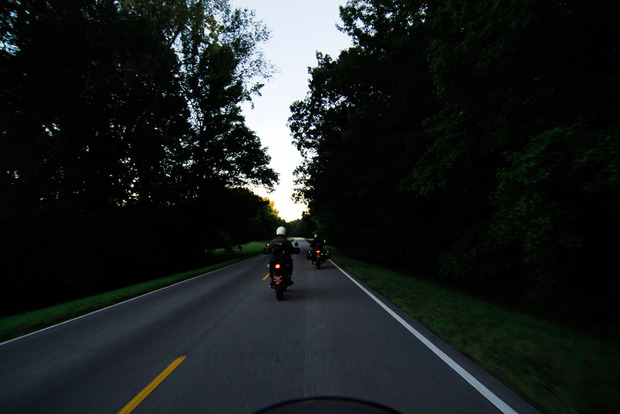
To share the experience over the following five days we will rehash the trip bit by bit, with road-tested gear reviews and testimonials. Not all the gear stood up to the trip’s demands, but the few that did truly earned their spot on our list. To kick things off in rather obvious fashion, the following are the three motorcycles manned on our journey across the country.
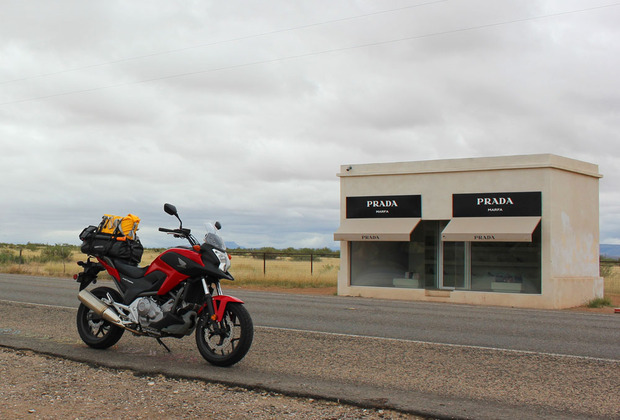
2013 Honda NC700X
As the more design-forward bike of the bunch, the modern hybrid Honda NC700X looked great and performed when and where it counted. A smooth power curve through all gears helped the overall ride experience—although to someone used to riding five-speed classics, the Honda’s sixth gear took a bit of getting used to—and provided enough power to bridge a tight gap at speed. Unlike most high-revving Hondas, the unique design of the NC700X’s parallel twin engine (essentially a car engine cut in half) provides low-end torque, bringing the power-band down to a much lower RPM than most. This makes close quarters city riding more manageable but leaves riders wanting more when topped out at freeway speeds. Handling-wise, the mid-sized Honda was very comfortable while cornering and maintained a steady ride profile with or without the weight of added bags. Of all the bikes, this one seemed fit for being pushed furthest in curves. Even if miscalculated, the bike had no problem leaning further mid-turn to get out of trouble. The somewhat squatty riding position was great at speeds, but when sustained for lengthier stretches put a lot of pressure on the knees. This can be attributed to using a bike not specifically designed for 500+ mile days to do just that, though.
As for keeping up with the pack, the NC700X has great fuel economy. While the gas tank was significantly smaller than the the Suzuki and Kawasaki, it could outride them both between gas stops. However, this was also the area of most aggravation during the trip, as the fuel tank is located under the rear end of seat, which made fueling up a real process. Each time all strapped-down baggage had to be removed to access the tank—a fairly nonsensical design decision. Again, this may be because the bike isn’t meant for long distance touring, but it seems silly even for weekend getaways. Tank placement issues aside, the NC700X is a very forgiving, very responsible and easy to ride bike. See Honda online for more.
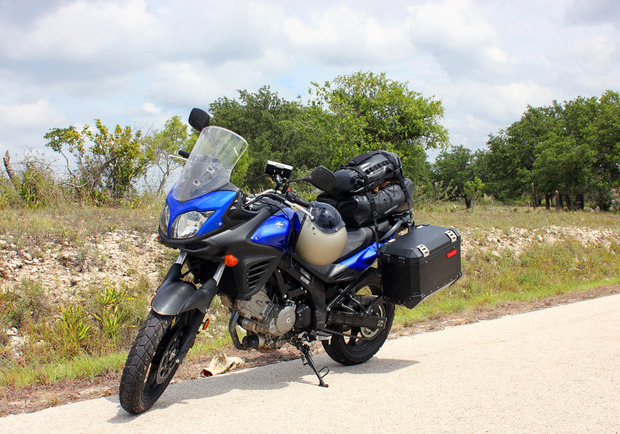
2013 Suzuki V-Strom 650 ABS Adventure
Plain and simple, the Suzuki V-Strom was the workhorse of the pack. Equipped with two hardcases big enough to fit the entire group’s camp gear without being bogged down, the sizable bike took lead most of the way. The power-band is extremely smooth, with plenty of low-end torque that—when paired with the ability to reach high RPM quickly—made for a bike that is exceptionally smooth and easy to ride in traffic or at freeway speeds. Even with fully loaded side-bags and two bags on the seat, the V-Strom had enough power to easily overtake slower moving traffic. Aiding in the smooth ride was the adjustable pre-load on the rear monoshock, which was extremely helpful in dialing in the ride to accommodate for additional weight. Plus two dual H-4 headlights that shed nearly as much light as car headlights, made riding at dusk (which we did just about every day in a rather foolish attempt to cover extra miles) and in the dark less sketchy.
With a seat that’s low enough to be comfortable off-road, yet wide enough to make long distances manageable, the V-Strom was definitely the most versatile bike of the three. Our only qualms with the Suzuki were how quiet it was—something that can be rather unnerving when approaching traffic at high speeds—and its less-than-sexy appearance. Find more specifics directly from Suzuki online.
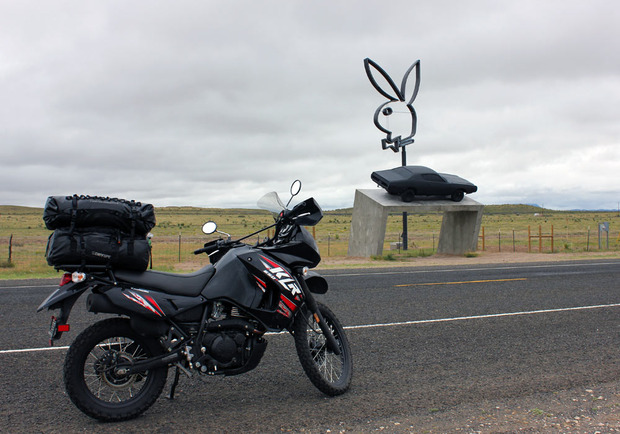
2013 Kawasaki KLR 650
As far as most are concerned, the Kawasaki KLR reigns supreme in the dual-sport category. Built for varied road conditions, the tall KLR proved to be a real machine off-road and, for the most part, pretty comfortable on the pavement as well. The four-stroke, single-cylinder KLR is fuel efficient, capable of carrying a decent payload and durable as hell. Day two delivered a less than accommodating gravel road in rural West Virginia and, even after being laid down a couple of times, the KLR was no worse for wear—save for a fairing fracture or two.
With an extremely high stand-over height, the KLR isn’t the easiest to mount, but once moving, the high ride height is great for varied terrain. On the highway, the 650cc engine provided plenty of get up for passing and sustaining speed, although the knobby tires made climbing past 80mph rather hairy, especially on California’s grooved highways. While we may not recommend running a similar number of miles in such a small timeframe—the narrow seat and prone riding stance were less than ideal for this—the KLR is a fun, fast bike fit for most any adventure. Visit Kawasaki online for more specs.
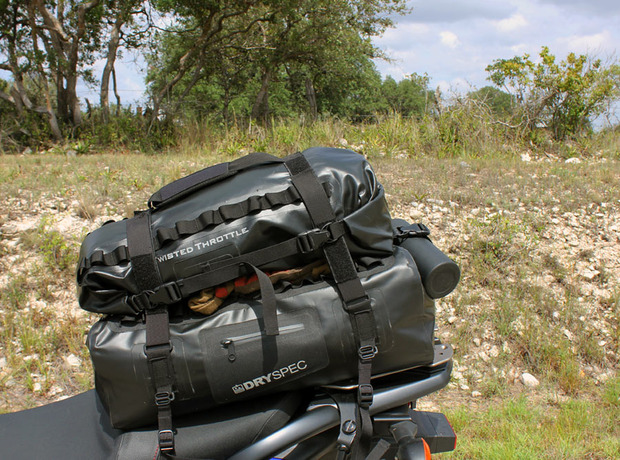
Twisted Throttle D38 + D28 Waterproof Dry Bags
As any seasoned traveler knows well, when it comes to wet weather, it’s not a matter of if, but when. And unfortunately for us, this little quip was confirmed the morning of day one as a torrential downpour escorted us out of Manhattan and proceeded to chase us through much of the Northeast. When packing for such a trip with so many unknown variables it’s best to prepare for the worst, so selecting dry bags a no-brainer. In fact, the unexpected afternoon rainstorm became rather expected, as we managed to hit crippling rain in nearly every state from the plains of Pennsylvania to the deserts of Texas and New Mexico. Thankfully the Twisted Throttle D38 Rigid Dry Bag combined with the small tootsie-roll style D28 Dry Bag made for an impregnable pack stack.
At 22″ long and with a capacity of 38oz, the larger D38 easily held 10 days worth of clothing and camp gear. The 28oz tubular design of the D28 made it perfect for stacking and its contents easily accessible—after a few days we learned to pack one end with rain gear and the other with a camera, making each available in seconds. The durable coated Cordura and 18oz vinyl stood up to pretty of abuse—and even a few spills. Find more information from Twisted Throttle online.
Lead images by Hunter Hess, bike and gear images by Graham Hiemstra. See more from the trip in the slideshow
Off Piste encourages exploration. With each feature we’ll introduce the people, products and places that make life outside the city possible and life in the city more down to earth.






















